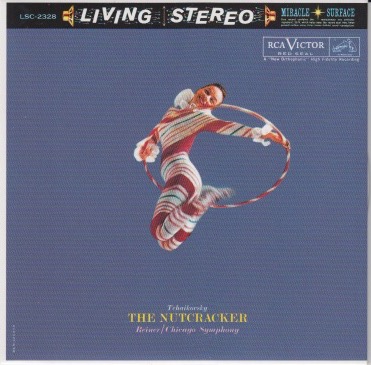
I knew it was going to come to this, sooner or later.
The Nutcracker.
The most notoriously kid-friendly, syrup-sweet, Christmas-themed composition in the history of compositions has taken refuge in my earphones today.
I took my wife to The Nutcracker ballet once, about 15 years ago. She told me that it was her favorite Christmas tradition. So I dutifully bought tickets, and gritted my teeth.
I’m usually suspicious of any music that, within a few notes, is identifiable and iconic. The opening notes of Movement III (The March), for example, are those notes. Within the first 30 seconds of hearing Movement III you know precisely what this is, and what it stands for. Very little is so immediately identifiable with Christmas (or the dreams of little girls wearing ballet shoes) the way The Nutcracker is. Ditto for Movement VI (Divertissement Tea), Movement VII (Divertissinment: Trepak), and Movement VIII (Divertissement: Dance of the Flutes). You can play snippets of either one of those to any child under the age of 10 and she (most likely a girl) will know what it is you’re playing.
Oh. And let’s not forget Movement 13 – Dance of the Sugar Plumb Fairy.
Very little says “Christmas time” more than that. It’s music that has become synonymous with the Yuletide holiday.
But is that a good thing?
I don’t know.
But I do know this music is, to me, like watching a commercial on TV. Or, more precisely, the jingle of a commercial. To me, this is akin to “two patties special sauce lettuce cheese pickles onions on a sesame seed bun.”
Today will give me the chance to hear The Nutcracker in a setting other than a crowded concert hall with dancers and toy soldiers be-bopping in front of my peepers.
At this level, detached from the hustle and bustle of Christmas, I will finally be able to judge Tchaikovsky’s The Nutcracker more objectively.
Maybe.
The Objective Stuff
From its entry on Wikipedia,
The Nutcracker (is an 1892 two-act ballet (“fairy ballet” originally choreographed by Marius Petipa and Lev Ivanov with a score by Pyotr Ilyich Tchaikovsky (Op. 71). The libretto is adapted from E. T. A. Hoffmann’s story “The Nutcracker and the Mouse King”.
Although the original production was not a success, the 20-minute suite that Tchaikovsky extracted from the ballet was. The complete Nutcracker has enjoyed enormous popularity since the late 1960s and is now performed by countless ballet companies, primarily during the Christmas season, especially in North America. Major American ballet companies generate around 40% of their annual ticket revenues from performances of The Nutcracker. The ballet’s score has been used in several film adaptations of Hoffmann’s story.
Tchaikovsky’s score has become one of his most famous compositions. Among other things, the score is noted for its use of the celesta, an instrument that the composer had already employed in his much lesser known symphonic ballad The Voyevoda.
After the success of The Sleeping Beauty in 1890, Ivan Vsevolozhsky, the director of the Imperial Theatres, commissioned Tchaikovsky to compose a double-bill program featuring both an opera and a ballet. The opera would be Iolanta. For the ballet, Tchaikovsky would again join forces with Marius Petipa, with whom he had collaborated on The Sleeping Beauty. The material Petipa chose was an adaptation of E. T. A. Hoffmann’s story “The Nutcracker and the Mouse King”, by Alexandre Dumas called “The Story of a Nutcracker”. The plot of Hoffmann’s story (and Dumas’ adaptation) was greatly simplified for the two-act ballet. Hoffmann’s tale contains a long flashback story within its main plot titled “The Tale of the Hard Nut”, which explains how the Prince was turned into the Nutcracker. This had to be excised for the ballet.
Petipa gave Tchaikovsky extremely detailed instructions for the composition of each number, down to the tempo and number of bars. The completion of the work was interrupted for a short time when Tchaikovsky visited the United States for twenty-five days to conduct concerts for the opening of Carnegie Hall. Tchaikovsky composed parts of The Nutcracker in Rouen, France.

The first performance of the ballet was held as a double premiere together with Tchaikovsky’s last opera, Iolanta, on 18 December [6 December] 1892, at the Imperial Mariinsky Theatre in Saint Petersburg, Russia.
You can read about Tchaikovsky (1840-1893) here.
The Nutcracker was composed in 1892. Tchaikovsky was 52. This performance was recorded on March 30, 1959. Maestro Reiner was in his 71st year of life.
The Subjective Stuff
Recording quality: 4
Overall musicianship: 5
CD booklet notes: 1
CD “album cover” information: 3 (not much info here)
How does this make me feel: 4
This was much more enjoyable than I thought it would be. I just had to weed out all of the extra feelings I had about the music and just listen to it.
When I did, I discovered that the aforementioned music is so iconic, so immediately recognizable because it’s so good, not because it’s the musical equivalent of a Kardashian – you know, famous for being famous.
These Tchaikovsky works are iconic because Tchaikovsky had the talent to make them so. It was his imagination that made them so memorable.

Again all better judgement, I have to admit that I’d listen to this again. Maybe more than once.
Just not at the theater.
Gotta love the advertisement on the back of the album cover.
